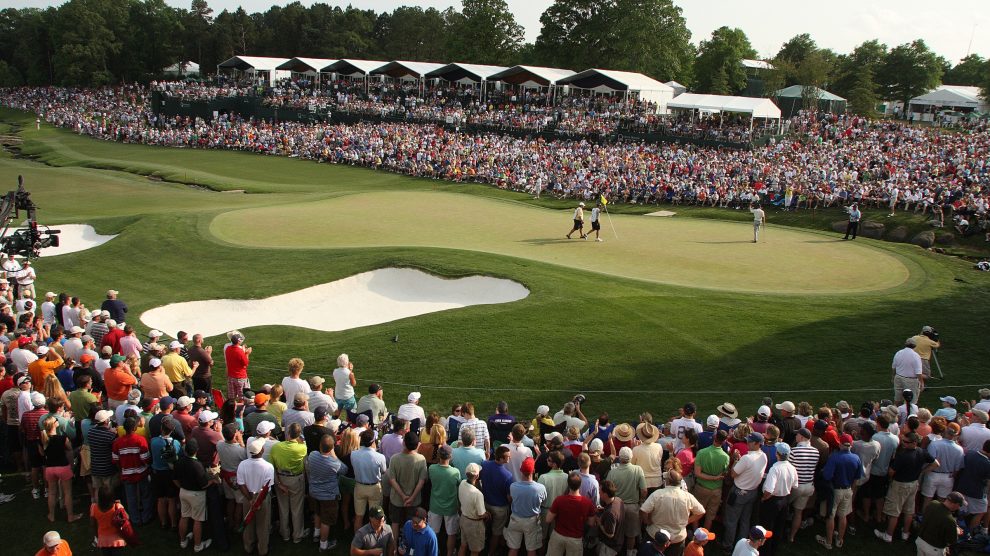Hard to believe the year’s final (until 2019) major championship is upon us this week at Quail Hollow Club in Charlotte. The annual host of the Wells Fargo (née Wachovia) Championship has undergone some rather significant changes in preparation for this year’s PGA and in anticipation of hosting the Presidents Cup in 2021.
As the 2016 tournament was coming to a close, crews were already at work on the front nine “removing all the sand from bunkers and preparing the greens to be gassed, stripping all the grass from them.” Every single putting surface was regrassed. The previous strain of Bermuda MiniVerde (a genetically modified turf) was scrapped in favor of the newest Bermuda strain du jour called Champion G-12, which was hauled in from Texas using refrigerated semi-trucks. No easy feat with only 15 months before the PGA Championship.
Course history
Before diving into the course and its changes, a brief history of the course. The course was originally designed by famed golf course architect George Cobb in 1961 to capture the beauty as well as challenging terrain of the Piedmont region. In the intervening years, the course has undergone a series of improvements, including modifications to several holes by Arnold Palmer in 1986, with redesigns by Tom Fazio in 1997, 2003 and the most recent renovations this past year.
Quail Hollow changes
The main reconstruction of entire holes centered on the par-4 first, the par-3 second and the par-5 fifth, which was turned into two new holes. But these changes were actually part of Fazio’s masterplan that stretched back to 1996. As Ron Whitten explains, “A first round of changes occurred in 1996 and included the creation of a man-made stream gurgling down the left edge of the par-4 18th hole, posing the threat of calamity on drives and second shots. In 2013, Fazio created an entirely new par-4 16th, edging the club's magnificent 15-acre lake.”
With a seemingly bottomless budget, Fazio basically acted as general contractor, hiring three separate firms to handle each of the three holes being reconstructed. So, there were basically three mini course projects under one large umbrella. Players will also “enjoy” the bunkers. Every single one was reconstructed with a vertical edge of stacked sod and filled with Spruce Pine feldspar; the very same type of sand found in Augusta National’s (remains to be seen if they’ll be as blindingly white on TV).
Holes to Watch
Hole 1 - PAR 4 | 524 YDS
Lengthened during the most recent course additions in 2016, the first hole is now in essence a combination of the former first and second holes. A long, left to right tee shot will place players atop an elevated landing zone and beyond the edge of the dogleg. From here, players will face a mid to long iron for their second to a small and undulating green protected by three large bunkers.
Hole 4 - PAR 3 | 184 YDS
Carved out of land that was once the former par-5 fifth hole, the new par-3 fourth will present an entirely new challenge for players. Framed by a group of tall pines, the fourth features a large undulating green fronted by three bunkers. Although the trees will not come into play, shots that fly long will end up below the green surface resulting in a difficult up and down.
Hole 5 - PAR 4 | 449 YDS
The fifth will be another new challenge for players. A result of 2016 additions, it plays down, and back up a shallow valley to a green that sits on a hillside behind the sixth tee. This slight dogleg right requires a well-placed tee shot to find a fairway protected by bunkers on either side. On their approach, players will face a narrow green that is well-guarded by a front right bunker.
Hole 16 - PAR 4 | 506 YDS
This is the beginning of the “Green Mile” -- one of the toughest finishing stretches in professional golf. The hole was modified in 2013 and the green was moved 80 yards to the left and now sits on the edge of the lake. What was once a straight away par-4 is now a dogleg right that demands an accurate tee shot that will leave a demanding mid-iron shot into a green guarded on the left by water.
Hole 17 - PAR 3 | 223 YDS
The green on Quail Hollow’s Signature Hole is nearly an island, forcing a carry of nearly 195 yards but can play much shorter if one of the forward teeing grounds are used. With the variety of hole locations available on this green it can be hole where bogies or worse can outnumber the number of birdies. In 2013 the tees on this hole were relocated to the site of the old 16th green.
Hole 18 - PAR 4 | 494 YDS
One of the toughest closing holes in golf. Players must avoid a bunker on the right, as well as a creek that meanders along the entire left side of the narrow fairway. An uphill second shot must avoid hazards on both sides of the green, which is deep and sloped.

